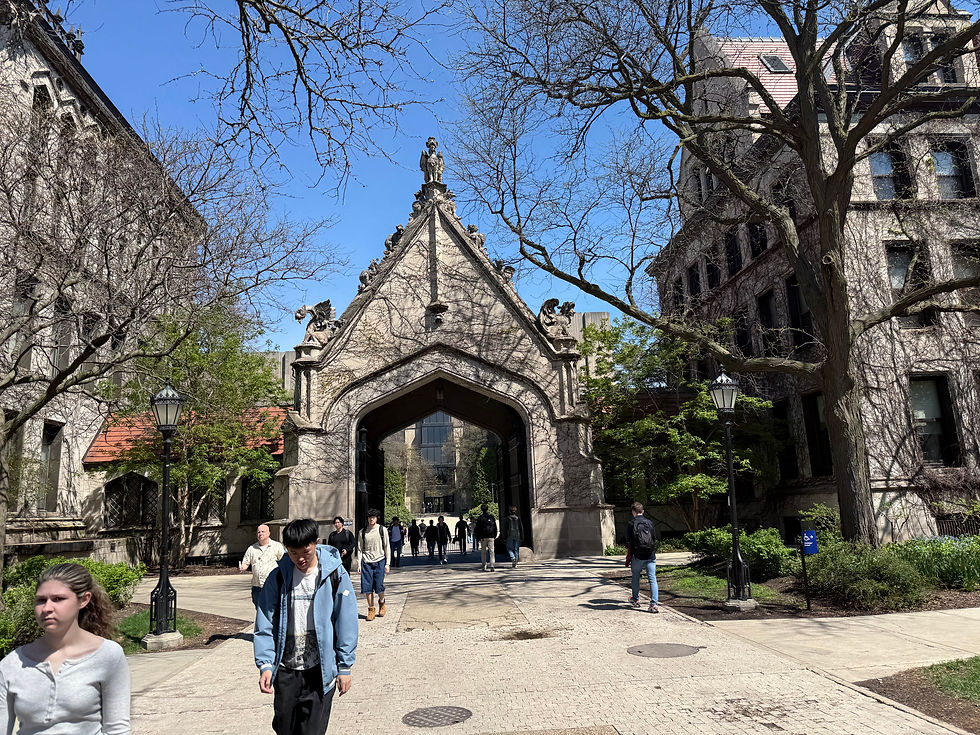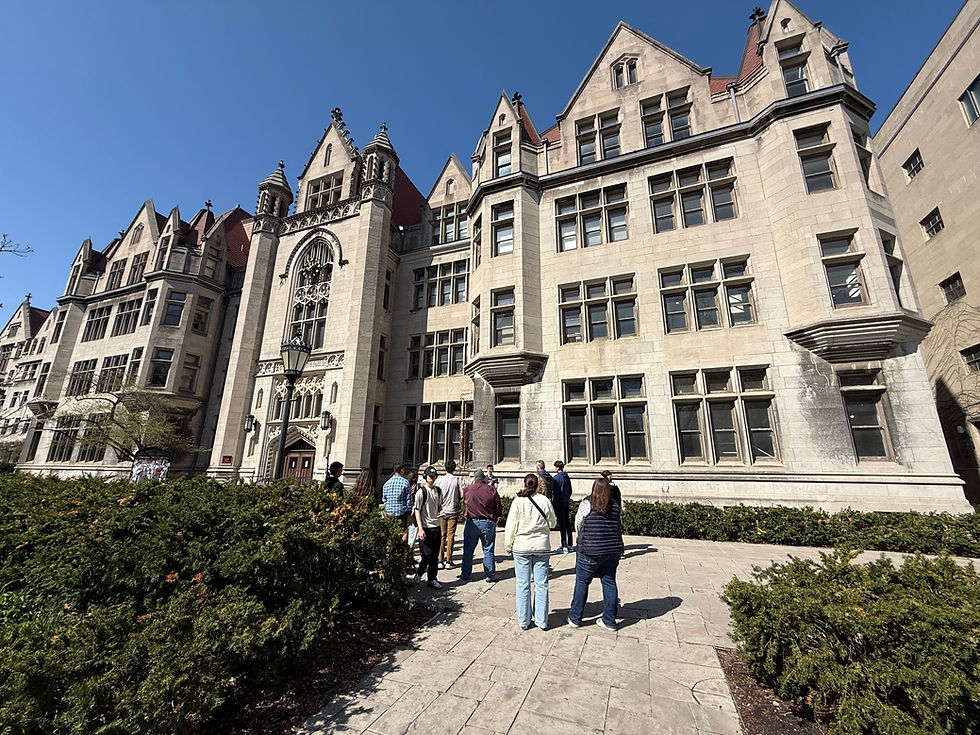University of Chicago -- Where Fun Is Learning
- educ8fit
- Aug 5
- 7 min read
Academics at the University of Chicago
The University of Chicago is very focused on academics. Many students and parents have heard that the University of Chicago is “where fun goes to die.” The reality is that it is a place where students think learning is fun. The saying about where fun goes to die comes from a period in the 1930’s when the University of Chicago temporarily eliminated its football team because the emphasis on athletics was harming the academic culture at the school.

The University of Chicago operates on a quarter calendar, where students typically take 12 courses over three terms. Students often find that taking classes over a quarter system is a faster pace compared to a semester calendar, where students take courses over two terms.
The University of Chicago typically requires students to take six courses in its core curriculum by the end of their sophomore year. The University of Chicago’s core classes are Socratic-style discussion courses. These courses form the heart or foundation of critical thinking. The size of core classes is capped at 19 students, and the classes could have as few as five to six students. Students must take a core humanities class freshman year.
The University of Chicago pays a lot of attention to undergraduate students. The average class size is 25, and the student-to-teacher ratio is 5:1.

The University of Chicago emphasizes theoretical academics over vocational training and teaches students how to think. The school helps prepare students for a “way of experiencing and moving through the world.” The University of Chicago offers undergraduates a major in molecular engineering but NOT in business. The University of Chicago emphasizes courses in economics rather than those in finance. The University of Chicago does, however, have an excellent graduate business program at its Booth School of Business. With that said, undergraduates have access to some graduate business classes. I was particularly excited during my visit to the University of Chigo because a client of mine was admitted to Booth during my tour.
The University of Chicago’s organizes its undergraduate program into these collegiate divisions:
The University of Chicago offers support to students who need academic assistance. Its Center for College Student Success (CCSS) provides resources and tools. In addition, it hosts events to promote a sense of belonging for first-generation college students.
Over 80 percent of students are involved in research, which takes place in all academic fields. The University of Chicago has over 100 research centers, including museums.
While the University of Chicago is rigorous academically, 99 percent of undergraduate students graduate on time.
Students can typically receive college credit for a 4 or 5 on an AP exam or for a 6 or 7 (out of 7) in an IB class. However, a biology major likely will not get out of the introductory biology class, but might be placed in an accelerated introductory biology class. Other selective colleges, like Duke University, have a similar arrangement. Some students graduate early from the University of Chicago, but students rarely graduate more than one quarter early.
University of Chicago Admissions
The University of Chicago receives approximately 43,000 applications, and around 4 percent of the applicants are admitted. Each application reader reads 1 to 1.2 thousand applications each year.

University of Chicago Applications.
The University of Chicago is on the Common Application; the Coalition Application; and QuestBridge, a method economically disadvantaged students use to apply to college. Applicants can apply Early Decision (ED), Early Action (EA), and Regular Decision.
The University of Chicago offers three rounds of applying ED. In addition to EDI and EDII, it offers what some call ED0. If an applicant participated in an eligible in-person or online University of Chicago summer program, the applicant can apply for Summer Student Early Notification (SSEN). When applying via SSEN, students apply between September 1 and October 15 and receive a response in three weeks, or before November 1, hence ED0.
Students who apply ED typically get a yes or no response. Students who apply EA are more likely to be deferred until decisions are made about applicants applying regular decision.
University of Chicago Transcript Review.
The University of Chicago evaluates transcripts for grades and rigor, and likes to see positive trends for both. The University of Chicago evaluates students in the context of their high school. Students should not feel compelled to self-study for an AP class.
University of Chicago Essays.
Students submit 3-5 pages of essays in their applications, which is their opportunity to stand out. The personal statement should be personal—do not focus the essay on another person. Successful essays do not have to be about trials, tragedies, or triumphs. The University of Chicago wants to see some reflection in the essay.
Keep in mind that the University of Chicago is not a vocational school. It values intellectual curiosity. One admissions representative said that he is unlikely to admit a student who writes about wanting to go to the University of Chicago as part of a pathway to becoming a physician.
Why us essays should focus on “how us” so that the University of Chicago understands how the applicant would engage with the school if admitted. Legacies should be aware that the University of Chicago expects them to write a great why us essays. Students should not just write about their major in the essay since they will take at least as many courses outside of their major while at the University of Chicago. Somewhat surprisingly, one admission representative said it is fine for applicants to write about the city of Chicago in the why us essay.
The University of Chicago also has the “uncommon extended essay.” The potential topics will strike many prospective students as being odd, such as “What is so easy about pie?” or “Is a hotdog a sandwich?” If the topics “bug” a prospective applicant, he or she should consider focusing on other colleges.
University of Chicago recommendations.
Applicants should provide recommendation letters from two core academic teachers. Students should select the teachers who know them the best, and can speak to their level of engagement and work ethic. Students can submit a third supplemental recommendation.
University of Chicago activities.
The University of Chicago does not care about what an applicant to be involved in, but it wants students to be involved. The typical University of Chicago student, even amongst athletes, will have a passion for an academic interest.
The engagement in an interest should be over multiple years, and their should be some kind of impact, even if it is small. The University of Chicago defines leadership broadly. Leadership is more than just a title. It can include tutoring and helping a sibling.
University of Chicago optional video.
Applicants may submit videos as part of their application. One applicant submitted a video where he went through a math proof, and he was admitted partly because of the level of excitement he displayed. Please be aware that the University of Chicago no longer conducts interviews, and the video is an opportunity to display interpersonal skills.
University of Chicago test scores.
The University of Chicago has been test-optional since 2018, prior to COVID. It says that it has a “no harm” test policy and that test scores are only considered if they benefit a student in admission.
University of Chicago Affordability
The cost of attendance at the University of Chicago is over $98,000 a year. However, most students receive need-based aid. The University of Chicago believes that its Net Price Calulator is accurate to within $5 if the families enters complete information.
The University of Chicago typically offers free tuition to first-generation college students and students from families with incomes below $125,000. Families with incomes below $60,000 will have their room and board covered as well as the tuition. The goal is for students to graduate debt-free.
About 10 percent of students receive a merit scholarship, and applicants are automatically considered for those scholarships. The University of Chicago also offers scholarships to children of first responders.
University of Chicago Housing
The University of Chicago expects students to live on campus during their first two years, and it guarantees housing for all four years. Half of all students live on campus all four years. Leasing agents are available to help students rent off campus. The University of Chicago’s Hyde Park campus can feel like a college town, and many staff members live there as well as students.
There are seven dorms, which contain 48 different residential “houses.” Every dorm has a dining hall. The houses have 50-100 students in them.
University of Chicago Careers
Although the University of Chicago is not a vocational school, it places a strong emphasis on internships and preparing students for employment. The University of Chicago curates a list of 4,500 internships strictly for University of Chicago students. It screens the internships to ensure that students will grow as part of the internship. It also provides a subsidy for unpaid internships.

The University of Chicago helps students develop resumes in their freshman and sophomore years to help them attain internships. In addition, it provides career advisors with experience in their field of interest.
University of Chicago Students
The University of Chicago has 7,500 undergraduate students, and they are all in the same college. Some consider the University of Chicago to be the “most caffeinated” college. The typical University of Chicago student, even amongst athletes, will have a passion for an academic interest. Greek life is available but only about 15 percent of students participate.
The University of Chicago has a unique annual scavenger hunt. The hunt has resulted in peculiar things on campus, including a tiger cub brought by the zoo to fulfill the request for a tiger. There was also the beginning of a nuclear reactor one year.

The University of Chicago offers 450 clubs. Students in the investment club run a portfolio of $450 K. Greek life is available, but only about 15 percent of students participate. The university participates in Division III sports and is not a “tailgate school.”
Educ8Fit Consulting

I work with students and families on the college and graduate school admission process. I help them navigate such complexities as merit aid and international admissions. Please contact Educ8Fit Consulting at either Jim@Educ8Fit.com or College Admission Counseling | Educ8fit Consulting | United States, contact for a free 30-minute consultation.




Comments